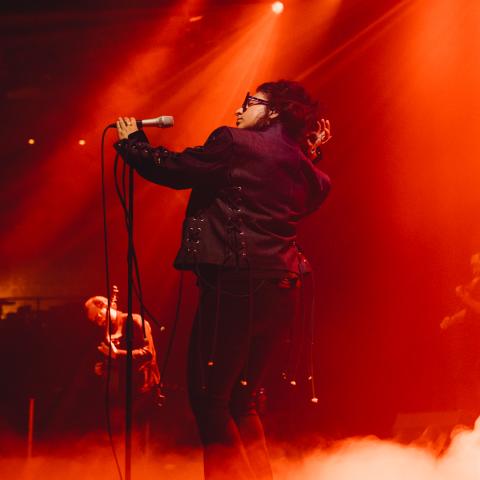Eric Marchwinski '10

Eric Marchwinski '10
“This is not real life.” That’s become an ongoing catchphrase expressed between lighting pro Eric Marchwinski ’10 and his friends in the touring industry. First as a student and member of the stage crew, when Paul Simon asked him to tune his guitar before a show at the BPC. Years later, while on tour with the Rolling Stones as lighting programmer, when Mick Jagger sat beside him on stage for an idle chat. And most recently on the field during the 49th Superbowl for the spectacular Katy Perry halftime show, the capstone of a world tour for which the Music Production and Engineering (MP&E) graduate estimates he spent 15 hours a day for nine weeks working with the video team.
Despite his relatively short time in the industry, the 26-year-old’s résumé reads like that of someone twice his age; he’s already through one and a half 52-page passports from touring the globe with Usher, Pearl Jam, Bon Jovi, and Beyoncé, among a growing who’s-who list of top-grossing acts. He founded Earlybird Design Inc. and sister-company Earlybird Visual, a collective of programmers, designers, and 3-D artists providing design support services for the entertainment industry—including events for Oprah and the NBA. With credits as diverse as his clients, Marchwinski is in-demand as a lighting programmer, lighting director, video programmer, and associate lighting designer.
Asked to explain his role in layman’s terms, Marchwinski says, “I play with hundreds of robots all at once. You make a giant list of the show and what you want the lights to do in each one of those queues.” He automates the show down to the millisecond, and for huge productions, many man-hours are spent in preparation of programming. “It’s a giant network, and everything needs to communicate.”
For mega-tours, acts such as Katy Perry and Usher approach top lighting designers like Baz Halpin to work on the overall vision for the stage design who will then entrust Marchwinski to program, design the queues and nuances, and stitch it all together. “That collaborative process is very interesting to me, because I’m learning how to eventually sit in the production designer seat, [by seeing] Baz interact with the artist,” Marchwinski says. “Watching that process from a mere 10 feet away is very vital to [developing] the skill set to be able to do that.”
Marchwinski’s introduction to live production came from lighting shows at his high school in upstate New York and gaining gig experience through the small audio division of a local music store. With the encouragement of his musician father and artist mother (both pursued nursing careers), Marchwinski knew early on he wanted a music-related profession. He had no conflicts about where he wanted to go; he applied to only one college.
“If I didn’t go to Berklee, I’m confident that my career path would not be this great, maybe not as accelerated either,” Marchwinski says. “You’re right in the middle of all the action, and that breeds a sense of independence. The MP&E program is a giant foundation and breeding ground that allows you to figure out where you want to take it next.”
While he initially thought he would become a live sound engineer, Marchwinski landed a work-study job on Berklee’s stage crew, and gravitated toward lights and programming. He progressed from lighting drum clinics and singer showcases to special events and major tour stops at the BPC, including the likes of John Mayer and Herbie Hancock. “I loved it,” Marchwinski says. “Whenever I wasn’t in the studio, practicing, or doing school work, I was in the BPC or one of the other halls working.”
By the time he graduated, Marchwinski had already toured once for a two-credit course and had designed and programmed the lighting for the commencement concert for his graduating class, a gig he picked up again two years later. While attending Berklee, Marchwinski recognized his passion for lighting but remained determined to complete his degree in MP&E. “It was a very unique program—you were not a number,” Marchwinski says, who still keeps in touch with the network of Berklee contacts he’s made, including professor Mitch Benoff.
“The crossover between visuals and music is not that uncommon,” Benoff says, having worked in lighting design for more than 30 years, including a light sculpture for the 2004 Athens Summer Olympic Games. “Marchwinski was incredibly creative as a producer and yet has been inventive in lighting, which uses technology just as production does,” Benoff says. Marchwinski echoes this sentiment and notes how it has accelerated his career path. “Since technology is developing so fast, it’s changing the model for how the younger generation can come up in the industry,” he relates. “My ability on the console I use allowed me to skip a lot of the steps of the old model where you’d become a lighting tech, then dimming guy, and then you’d be able to program.”
He also emphasizes the importance in the touring industry of being likable. What you may lack in technical knowledge is always made up for in amiable attitude, particularly when spending long hours with the same group of people. It’s a social aptitude he honed on the stages and studios at Berklee.
“The experience of Berklee and everything I learned there is invaluable,” Marchwinski says. He cites the influence of his final production project overseen by Benoff that helped him to rapidly apply his classroom learning to the live touring environment. “Regardless of what my degree says, learning how to collaborate with people, learning how to work on a team, learning how to be creative, were the most valuable parts of my Berklee experience.”
Curtis Killian is a web content producer at Berklee




